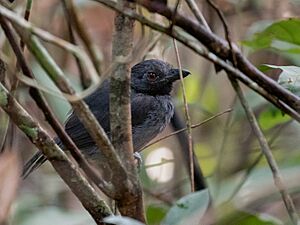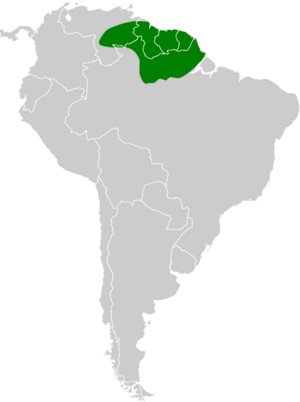Black-throated antshrike facts for kids
Quick facts for kids Black-throated antshrike |
|
|---|---|
 |
|
| Male black-throated antshrike | |
| Conservation status | |
| Scientific classification | |
| Genus: |
Frederickena
|
| Species: |
viridis
|
 |
|
The black-throated antshrike (Frederickena viridis) is a cool type of bird known as an antbird. You can find this bird in several South American countries. These include Brazil, French Guiana, Guyana, Suriname, and Venezuela.
Contents
Meet the Black-throated Antshrike
What's in a Name?
The black-throated antshrike belongs to a group of birds called Frederickena. It shares this group with two other antshrikes: the undulated antshrike and the fulvous antshrike. Scientists use these group names to organize living things.
How to Spot This Bird
The black-throated antshrike is a fairly large, dark bird. It grows to be about 19 to 22 centimeters (7.5 to 8.7 inches) long. It weighs around 65 to 75 grams (2.3 to 2.6 ounces).
Boys and girls of this bird look quite different.
- Both have a crest on their head, but it's usually flat. They also have red eyes and a strong black beak. This beak has a hook at the end, much like a true shrike bird.
- Male antshrikes are mostly dark gray. Their head, throat, and chest are black. They have a small white patch on their back that is often hidden. Their tail has faint white stripes.
- Female antshrikes have a reddish-brown crest, neck, back, and wings. Their face, belly, and tail have stripes of pale cream and dark brown. Their sides might look a bit reddish.
- Young males look a bit like adult females. They have a mix of gray and brown on their upper and lower parts.
Where Do They Live?
Their Home Range
You can find the black-throated antshrike in eastern Venezuela. From there, its home stretches east through countries like French Guiana, Guyana, and Suriname. It also lives in northeastern Brazil, north of the Amazon River. This area goes from the lower Rio Negro all the way to the Atlantic Ocean.
Preferred Habitat
These birds live in lowland evergreen forests. They especially like forests with sandy soil. They prefer dense plants and bushes close to the ground. You might find them in spots where trees have fallen, creating open spaces. They live from sea level up to about 700 meters (2,300 feet) high. In Venezuela, they are found up to 500 meters (1,600 feet).
Antshrike Behavior
Staying Put
The black-throated antshrike usually stays in the same area all year long. They don't migrate to other places.
What's for Dinner?
Scientists don't know every detail of what these birds eat. But they do know that black-throated antshrikes eat large insects. They also munch on other small creatures with exoskeletons, called arthropods.
They hunt alone or in pairs. They mostly look for food low to the ground or right on it. They search in thick plants and tangled vines. They hop carefully from branch to branch or along the ground. They reach out or jump from a perch to grab prey. They find food on leaves, stems, branches, and even in leaf litter or rotten logs. Sometimes, they follow swarms of army ants. This helps them catch insects that the ants scare out of hiding.
Family Life
In Suriname, black-throated antshrikes lay eggs between October and March. We don't know their breeding season in other places. Only one nest has ever been found. It was like a basket, hanging in a low bush. This nest held two eggs. The eggs were creamy white with purplish marks. We don't know how long the eggs took to hatch. We also don't know how long it takes for the young birds to leave the nest.
Bird Calls and Songs
The black-throated antshrike has a special song. It's a slow series of 10 to 15 flute-like "tuh" notes. These notes first go up, then level out, lasting about six to seven seconds. Some describe it as a slow, almost calming series of clear, strong whistles, like "peeeur, peeeur, peeur..." repeated steadily. Their call is a long, nasal, downward-sounding "churr" that lasts about one second.
Conservation Status
Is This Bird Safe?
The IUCN (International Union for Conservation of Nature) says the black-throated antshrike is a species of "Least Concern". This means it's not currently in danger of disappearing. It lives across a large area. We don't know exactly how many of these birds there are, but their numbers seem to be going down. No big threats have been found for them right now.
This bird is considered uncommon or rare in most places it lives. However, its home includes large areas of healthy forest. It also lives in at least two protected areas in Venezuela.


